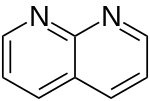1,8-Naphthyridine
1,8-Naphthyridine is an organic compound with the formula C8H6N2. It is the most well-studied of the six isomeric naphthyridines, a subset of diazanaphthalenes with nitrogen in the separate rings.[1][2] Enoxacin, nalidixic acid, and trovafloxacin are 1,8-naphthyridine derivatives with antibacterial properties related to the fluoroquinolones.[3]
 | |
| Identifiers | |
|---|---|
3D model (JSmol) |
|
| 109347 | |
| ChEBI | |
| ChEMBL | |
| ChemSpider | |
| ECHA InfoCard | 100.201.052 |
| EC Number |
|
| 27124 | |
PubChem CID |
|
| UNII | |
CompTox Dashboard (EPA) |
|
| |
| |
| Properties | |
| C8H6N2 | |
| Molar mass | 130.150 g·mol−1 |
| Appearance | yellow solid |
| Density | 1.359 g/cm3 |
| Melting point | 98–99 °C (208–210 °F; 371–372 K) |
| Hazards | |
| GHS pictograms |  |
| GHS Signal word | Warning |
GHS hazard statements |
H315, H319, H335 |
| P261, P264, P271, P280, P302+352, P304+340, P305+351+338, P312, P321, P332+313, P337+313, P362, P403+233, P405, P501 | |
Except where otherwise noted, data are given for materials in their standard state (at 25 °C [77 °F], 100 kPa). | |
| Infobox references | |
Coordination chemistry
With flanking nitrogen centers, 1,8-naphthyridine serves as a binucleating ligand in coordination chemistry.[4][5]
References
- Litvinov, Victor P.; Roman, Sergey V.; Dyachenko, Vladimir D. (2000). "Naphthyridines. Structure, Physicochemical Properties and General Methods of Synthesis". Russian Chemical Reviews. 69 (3): 201–220. Bibcode:2000RuCRv..69..201L. doi:10.1070/RC2000v069n03ABEH000553.
- Dapporto, P.; Ghilardi, C. A.; Mealli, C.; Orlandini, A.; Pacinotti, S. (1984). "Low-Temperature (163 K) Structure of 1,8-Naphthyridine, C8H6N2". Acta Crystallographica Section C Crystal Structure Communications. 40 (5): 891–894. doi:10.1107/S0108270184006144.
- V. P. Litvinov (2006). "Advances in the Chemistry of Naphthyridines". Advances in Heterocyclic Chemistry. 91: 189–300. doi:10.1016/S0065-2725(06)91004-6. ISBN 9780120207916.
- Hua, Shao-An; Liu, Isiah Po-Chun; Hasanov, Hasan; Huang, Gin-Chen; Ismayilov, Rayyat Huseyn; Chiu, Chien-Lan; Yeh, Chen-Yu; Lee, Gene-Hsiang; Peng, Shie-Ming (2010). "Probing the electronic communication of linear heptanickel and nonanickel string complexes by utilizing two redox-active [Ni2(napy)4]3+ moieties". Dalton Transactions. 39 (16): 3890–6. doi:10.1039/b923125k. PMID 20372713.
- Bera, Jitendra K.; Sadhukhan, Nabanita; Majumdar, Moumita (2009). "1,8-Naphthyridine Revisited: Applications in Dimetal Chemistry". European Journal of Inorganic Chemistry. 2009 (27): 4023–4038. doi:10.1002/ejic.200900312.
This article is issued from Wikipedia. The text is licensed under Creative Commons - Attribution - Sharealike. Additional terms may apply for the media files.